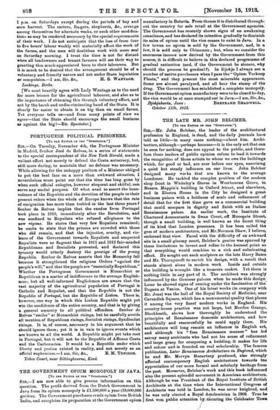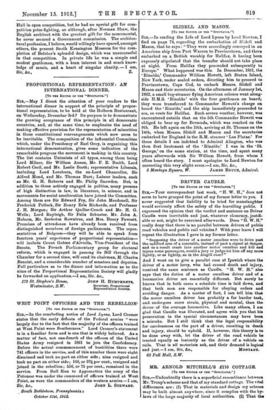THE LATE MR. JOHN BELCHER.
[To TBS EDITOR OF TUE "SPECTATOR."] S114,—Mr. John Belcher, the leader of the architectural profession in England, is dead, and the daily journals have told us little—in many cases nothing—about him. Archi- tecture, although—perhaps because—it is the only art that can be seen for nothing, does not appeal to the public, and there- fore these leaders of public opinion refuse to lead it towards the recognition of those artists to whom we owe the buildings which, for good or bad, are ever before our eyes, exercising a quiet but steady influence on our lives. John Belcher designed many wee ks that are known to the average Londoner. He tackled the complex problem of the modern shop front in Whiteley's Stores in Westbourne Grove, in Messrs. Mappin's building in Oxford Street, and elsewhere, and in Electra House in the City he designed a great business palace with a boldness of scale and refinement of detail that for the first time gave us a commercial building that could compare in dignity and finish with an Italian Renaissance palace. An earlier work, the Institute of Chartered Accountants in Swan Court, off Moorgate Street, though a small building, is well known as the finest thing of its kind that London possesses. It has been called the gem of modern architecture, and Mr.Norman Shaw, I believe, endorsed that view. Faced with the difficulty of an awkward site in a small gloomy court, Belcher's genius was spurred by these limitations to invent and refine to the keenest point so that everything would combine to a rich and culminating effect. He sought out such sculptors as the late Harry Bates and Mr. Thornycroft to enrich his design, with a result that stands almost alone in modern work. Inside and outside the building is wrought like a treasure casket. Yet there is nothing little in any part of it. The architect was strongly influenced by the Genoese palaces when he made this design. Later he showed signs of coming under the fascination of the Dogana at Venice. One of his latest works (in company with Mr. Joas) was the hall of the Royal Society of Medicine, near Cavendish Square, which has a monumental quality that places it among the very finest modern works in England. His country-house practice was not large, but Morden Grange, Blackheath, shows how thoroughly he understood the principles of Renaissance domestic architecture, and how beautifully and resourcefully he could apply them. His architecture will long remain an influence in English art, and although. his " free Renaissance manner" has led astray many architects who had not his sense of refinement and large grasp for composing a building, it makes for life and colour and is founded on real scholarship. The famous publication, Later Benaissanee Architecture in England, which he and Mr. Mervyn Macartney produced, also strongly affected contemporary English architecture towards the appreciation of our more formal and scholarly heritage from the past. Moreover, Belcher's work and this book influenced also the present splendid movement in American architecture. Although he was President of the Royal Institute of British Architects at the time when the International Congress of Architects was held in London, he was never knighted, and he was only elected a Royal Academician in 1909. True he first won public attention by securing the Colchester Town Hall in open competition, but he bad no special gift for com- petition prize-fighting, so although, after Norman Shaw, the English architect with the greatest gift for the monumental, he never secured a Government commission. The architec- tural profession, I believe, would willingly have spared, amongst others, the present South Kensington Museum for the com- pletion of Belcher's splendid design, which was unsuccessful in that competition. In private life be was a simple and modest gentleman, with a keen interest in and much know- ledge of music, and a heart of singular charity. —I am,































































 Previous page
Previous page